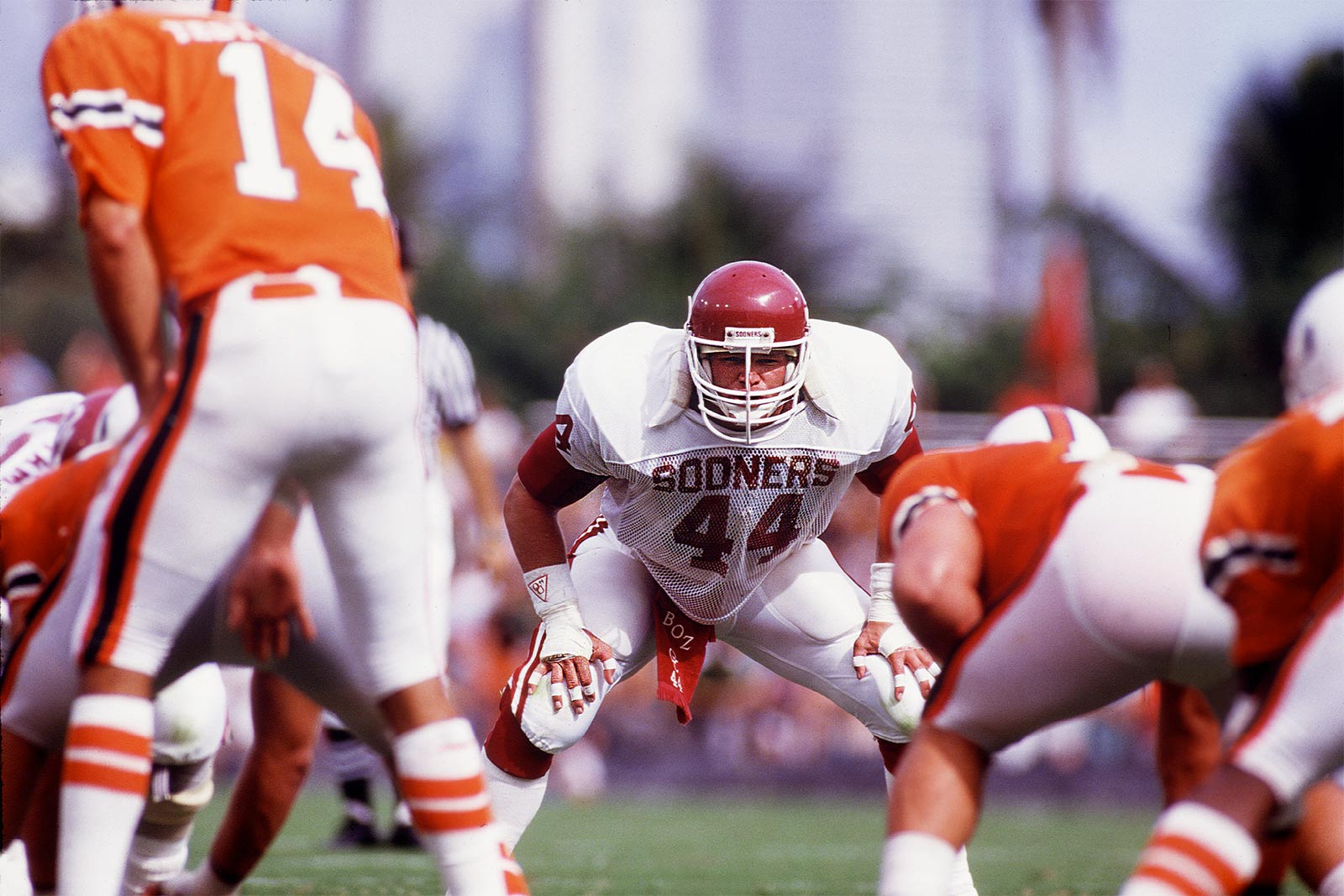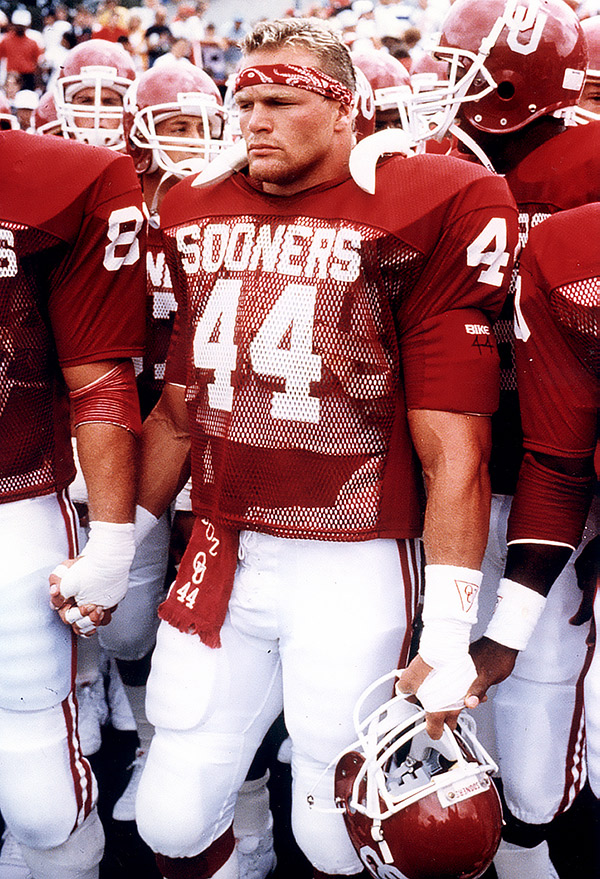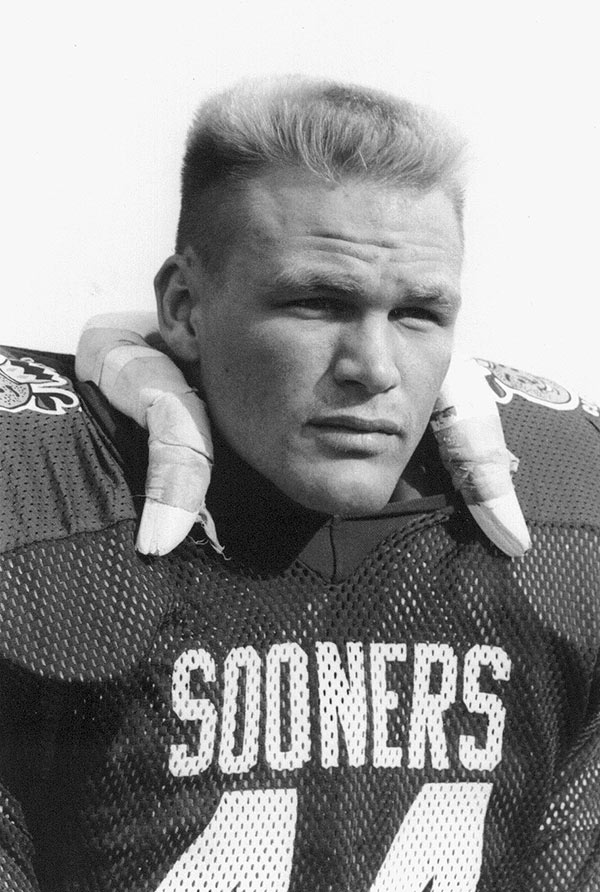One of the most iconic figures in college football history, Brian Bosworth opens up about what it means to be a part of the Hall of Fame.
Written by: John Rohde
Video Production: SoonerVision
Br35ian Bosworth checked his phone messages in early January and heard the voice of Steve Hatchell, who is President and CEO of the National Football Foundation & College Football Hall of Fame. Hatchell wanted Bosworth to return his call as soon as possible to share some news.
"I was afraid to call him back," Bosworth admitted, "because I thought it was a crank call." Bosworth’s trepidation was understandable. For nearly 20 years, Bosworth had been denied induction into the College Football Hall of Fame. Bosworth finally summoned the courage to call Hatchell and learned the wait was over.
"I just didn’t have any words," Bosworth said of his reaction. "I let it all sink in, so it’s been a wonderful ride."
By "a wonderful ride," Bosworth was referring to his football journey to the Hall of Fame, not the years it took to get there.
B5osworth becomes the 21st Sooners player to enter the Hall of Fame, where he will join former teammates Keith Jackson (2001) and Tony Casillas (2004) and coach Barry Switzer (2001). In addition to Bosworth being honored at Saturday’s OU-West Virginia game on Owen Field, the 1985 national championship team will be recognized at halftime.
This year’s class gives the College Football Hall of Fame a total of 963 players and 209 coaches. Given the size of those totals, Bosworth’s inclusion might seem obvious. However, nearly 5.12 million have played or coached college football in the past 146 years, which means less than two ten-thousandths of one percent (.0002) have been deemed worthy of induction.
Bosworth has now been placed in the top .0002 percent of all-time college players and he went through an array of emotions every time he was denied entry. Bosworth was exasperated, infuriated, offended, outraged, apathetic, sad and bitter. Waiting longer than anticipated for his selection has made Bosworth more appreciative.
“Without question, only because I wasn’t where I am now (as a person),” Bosworth said in an interview with Jessica Coody of Sooner Sports TV. “I wouldn’t have appreciated it (had he been selected earlier). I wouldn’t have taken it with the same gratitude and humility that it deserves because it really does represent the entire era of when we played – all those guys who were on the defensive side of the football (at OU), including the coaching staff. What we did as a unit, we did as a family, and we’re still close. I think that’s the definition of being part of the College Football Hall of Fame.”
A look back at the career of OU's latest Hall of Famer in his own words, with comments from Barry Switzer, Jamelle Holieway and Anthony Phillips.

Being able to join Switzer was particularly important to Bosworth. The clock was ticking and Bosworth didn’t want his induction to come too late.
“That (being inducted) was kind of the final piece to me being here at Oklahoma, because to me I really wanted that to validate what coach Switzer had seen in me.” Bosworth said. “I wanted to give him that honor back because he believed so much in me. What I really worried about was that there was this agenda to hold me out or keep me out or make me pay, or whatever their issues were with it that it eventually would come, but it would come after the passing of coach Switzer, which would have broken my heart.”
F9ive years ago, Bosworth was en route to a Subway sandwich shop in Malibu, Calif., when informed he again had been ignored. At that time, Bosworth said he was unaware an announcement was even scheduled. “I don’t really put a lot of importance on somebody else telling me what I did. I know what I did,” Bosworth said. “I don’t know anybody who doesn’t have skeletons in the closet. Hell, I brought my skeletons out for everybody to see. I walked my own walk. I had a great coach who allowed me to walk my own walk. Now, he didn’t want me to walk that walk, and in retrospect I wish I had not walked that walk.”
In late October of last year, a “30 for 30” ESPN film “Brian and the Boz” aired and showed an evolved Bosworth admitting his mistakes and flaws. Did this contrition finally sway Hall of Fame voters in Bosworth’s favor?
“I hope not,” Bosworth said. “Maybe partly so.”
The 50-year-old Bosworth has his alter-ego to thank for the delay. Brian Bosworth and “The Boz” are two different people. Bosworth likely would have been inducted shortly after he became eligible in 1996 (10 years after his final collegiate season). As for “The Boz,” well, he might have trouble getting into the College Football Hall of Fame as a patron.
“The Boz” sported a multi-colored Mohawk and filled opponent bulletin boards with inflammatory quotes, but how Bosworth looked didn’t keep him from being inducted as much as something he wore.
Suspended when he tested positive for anabolic steroids after the 1986 season, Bosworth wore a T-shirt inscribed with “National Communists Against Athletes” on the sideline during the Orange Bowl on Jan. 1, 1987. Bosworth started every game he ever played at OU, except his last one. He declared for the NFL Supplemental Draft shortly thereafter.
NCAA officials were livid about the T-shirt, as was Switzer. So, too, evidently were Hall of Fame voters. “I put me first instead of putting my team first,” Bosworth admitted years ago. “That was the wrong stage in which to have that protest.”
Even after Bosworth’s fall from grace, Switzer still endorsed him for the Hall of Fame. “He never was a bad citizen,” Switzer has said in the past. “He was an outstanding student. I guess being on the honor roll and graduating in 3½ years doesn't apply (to the Hall of Fame selection committee). He was a great student-athlete, but he made outrageous statements, he danced with the media, he created an image of The Boz. His play on the field should have been enough attention for him. He was a great player, a great practice player. He was never a disciplinary problem, other than keeping his damn mouth shut.”

Bosworth redshirted in 1983, played from 1984 through 1986 and never lost to Texas, Nebraska or Oklahoma State. Defensive statistics were obscure in those days and often altered by coaches after reviewing game film. Altered or not, Bosworth was a beast, averaging 138 tackles, 10 tackles for loss, four sacks, four passes broken up and recovering at least one fumble each season. His 22 tackles against Miami in 1986 remain tied for second most in school history (behind Jackie Shipp’s 23 against Missouri in 1981) and Bosworth’s 413 career tackles (in just three seasons) rank seventh.
Coincidentally, the NFF headquarters are located in Irving, Texas, just three miles from where Bosworth played at MacArthur High School.
The announcement of the 2015 Class was made at the Renaissance Dallas Hotel last January, three days before the first College Football Playoff national championship game was staged at AT&T Stadium in Arlington. This year’s class formally will be inducted at the 58th NFF Annual Awards Dinner on Dec. 8 at the Waldorf Astoria in New York City.
The inductees also will be honored at the National Hall of Fame Salute at the Allstate Sugar Bowl in New Orleans on Jan. 1, 2016. In addition to Bosworth, this year's class includes: Trev Alberts (Nebraska), Bob Breunig (Arizona State), Sean Brewer (Millsaps [Miss.]), Ruben Brown (Pittsburgh), Wes Chandler (Florida), Thom Gatewood (Notre Dame), Dick Jauron (Yale), Clinton Jones (Michigan State), Lincoln Kennedy (Washington), the late Rob Lytle (Michigan), Michael Payton (Marshall), Art Still (Kentucky), Zach Thomas (Texas Tech), Ricky Williams (Texas) and coaches Bill Snyder (Kansas State) and Jim Tressel (Youngstown State, Ohio State).

1. First and foremost, a player must have received first-team All-America recognition by a selector organization that is recognized by the NCAA and utilized to comprise their consensus All-America teams.
2. A player becomes eligible for consideration by the Foundation's honors courts 10 years after his final year of intercollegiate football played.
3. While each nominee's football achievements in college are of prime consideration, his post football record as a citizen is also weighed. He must have proven himself worthy as a citizen, carrying the ideals of football forward into his relations with his community and fellow man. Consideration may also be given for academic honors and whether or not the candidate earned a college degree.
4. Players must have played their last year of intercollegiate football within the last 50 years*. For example, to be eligible for the 2015 ballot, the player must have played his last year in 1965 or thereafter. In addition, players who are playing professionally and coaches who are coaching on the professional level are not eligible until after they retire.
5. A coach becomes eligible three years after retirement or immediately following retirement provided he is at least 70 years of age. Active coaches become eligible at 75 years of age. He must have been a head coach for a minimum of 10 years and coached at least 100 games with a .600 winning percentage.
1. Nominations may be made only by a due-paying member of the National Football Foundation or by Athletic Directors, Coaches or CoSIDA member representing dues-paying colleges/universities.
2. Statistics, newspaper/magazine clippings, records and personal recommendations by coaches, fellow players and opponents are all considered.
3. The National Football Foundation staff screens each candidate. After ascertaining that the nomination satisfies all requirements, the nominee is submitted to the District Screening Committee (DSC) nearest to the institution where the nominee played. New nominees as well as individuals who appeared on the previous year's ballot will be included in this process.
4. Only the top vote-getters (approximately 60 players) from the DSC are forwarded to The National Football Foundation staff for inclusion on the ballot. The ballot also carries names of candidates held over from the previous year. These carryover names are referred to as "automatic holdovers" and are decided upon by the Honors Court. Thus, even though a player is nominated, his name WILL NOT appear on the national ballot if he does not first pass through the DSC.
5. The ballot of players and coaches is mailed to all dues-paying members of The National Football Foundation for a member vote. The results are compiled and provided to the Honors Court, which determines the final class members, to be used as a reference.
6. Any candidate not selected to the current year's Hall of Fame class will automatically go through the voting procedures again the following year. There is no need to nominate the candidate again.
*Those players who do not comply with the 50-year rule may still be eligible for consideration by the FBS and Divisional Veterans Committee, which examines unique cases.